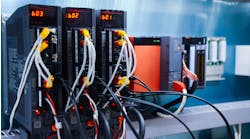MULTICHANNEL TRANSMITTER
Figure 2. Device can take three pH sensor inputs and send the average of the two closest readings to the control system.
Or the sensors may be seeing different pH because of where they're mounted within the process. If the sensors are installed in a tank, maybe one is closer to a mixer or a reagent addition line. In either case, the two sensors aren't seeing the same value. Streaming potentials (an electric current that occurs when an electrolyte is driven through the sensor) also may affect the pH value, depending upon where the sensor is mounted in relation to the other sensor. Bottom line: Having two sensors is no better than having a single sensor.The best option is to use three sensors and disregard the reading that differs most and average the other two to get a reasonable interpretation of true process pH. The sensors should be mounted as close as possible to each other to minimize potential differences. Three sensors will cost a little more upfront. However, in the long run, the accurate measurements achieved can lead to substantial economic benefits in many applications — for instance, in any process where tight pH control will save reagents, increase product quality, prevent process upsets or equipment damage, or where fines may be levied if pH outfall exceeds regulatory limits. And now, new devices like multichannel transmitters (
Figure 2) with three-input capability and digital sensor technology reduce costs. You don't need three pH transmitters — just three pH sensors and one transmitter. The multichannel transmitter detects differences among the three pH sensors and calculates an average value of the two closest readings, which it then sends to the control system. By using three pH probes and a single transmitter, you can shorten working time in highly critical applications.
A CLEAN SENSOR IS CRUCIALFor a pH sensor to maintain accuracy, it must remain clean. The glass measuring electrode can't become coated; similarly, the reference electrode assembly can't become coated, plugged or otherwise contaminated by the process solution. I've provided guidance on proper cleaning procedures in a previous article, "
Maintain Accurate pH Readings."With a three-sensor system, it's easier to determine when a sensor needs cleaning. If one consistently reads pH differently than the other two, then it probably requires cleaning and calibrating. Without such a system, the plant has no way of knowing when a sensor needs service — so it typically performs cleaning and calibration on a scheduled basis, in some cases when the sensor is perfectly fine. This is a waste of time.With a modern pH sensor and a multichannel transmitter, it's easy to replace the questionable sensor. It's simply a matter of swapping in a precalibrated unit.
FREDERICK KOHLMANN is analytical product business manager for Endress+Hauser, Greenwood, Ind. E-mail him at [email protected].

